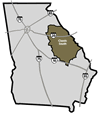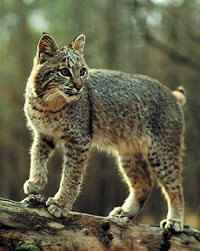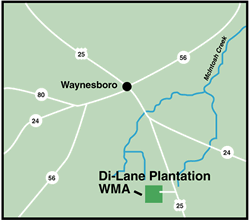
Wildlife Viewing Guide


|
Wildlife Viewing Guide |
 |
 Di-Lane
Plantation Wildlife Management Area
Di-Lane
Plantation Wildlife Management Area Description:
Di-Lane Plantation is an 8,100-acre WMA situated in Georgia's Upper Coastal
Plain. About 70 percent of the area is forested, primarily in natural stands
of upland hardwoods and pines. The understory varies from dense thickets of
palmetto, wax myrtle, and gallberry to open grassy meadows. The remaining 30
percent is in various stages of old-field succession intermixed with wildlife
plantings to enhance habitat. The area has some outstanding wetland habitats
that harbor many species of native resident and migratory wildlife. Laurel oaks
draped in Spanish moss line the entrance road that passes a pet cemetery established
by a previous owner in tribute to his bird dogs.
Description:
Di-Lane Plantation is an 8,100-acre WMA situated in Georgia's Upper Coastal
Plain. About 70 percent of the area is forested, primarily in natural stands
of upland hardwoods and pines. The understory varies from dense thickets of
palmetto, wax myrtle, and gallberry to open grassy meadows. The remaining 30
percent is in various stages of old-field succession intermixed with wildlife
plantings to enhance habitat. The area has some outstanding wetland habitats
that harbor many species of native resident and migratory wildlife. Laurel oaks
draped in Spanish moss line the entrance road that passes a pet cemetery established
by a previous owner in tribute to his bird dogs.
Viewing Information: In addition to providing habitat for game birds,
such as bobwhite quail, mourning doves, and wild turkeys, Di-Lane Plantation
is also home to many nongame birds, including bluebirds, sparrows, and warblers.
During the late fall and early spring, large numbers of hawks can be observed
hunting the open fields. Many wood ducks and a variety of other waterfowl roost
throughout the area in winter. Other common winter wetland birds include great
blue and green herons and occasionally wood storks. The abundant early successional
habitats intermixed with mature forests maintain high populations of prey species,
including  rabbits,
fox squirrels and gray squirrels, white-tailed deer and numerous rodents. Because
of the excellent populations of prey,Di-Lane is a good place to observe predators
such as gray and red foxes, bobcats and coyotes. Other common mammals include
raccoons, opossums, skunks, and beavers. River otters are occasionally observed.
Several species of bats commonly occur in the area. A variety of turtles, frogs,
salamanders, and snakes occur throughout the area. Three of Georgia's six venomous
snakes are found in the area, including cottonmouths, copperheads, and timber
rattlesnakes. The American alligator is a common summer sight.
rabbits,
fox squirrels and gray squirrels, white-tailed deer and numerous rodents. Because
of the excellent populations of prey,Di-Lane is a good place to observe predators
such as gray and red foxes, bobcats and coyotes. Other common mammals include
raccoons, opossums, skunks, and beavers. River otters are occasionally observed.
Several species of bats commonly occur in the area. A variety of turtles, frogs,
salamanders, and snakes occur throughout the area. Three of Georgia's six venomous
snakes are found in the area, including cottonmouths, copperheads, and timber
rattlesnakes. The American alligator is a common summer sight.
Directions: From Waynesboro, take 4th ave./Herndon Rd. south 10 miles and follow signs to the check station.
Management: Georgia DNR, Wildlife Resources Division, 706-595-4222
Closest Town: Waynesboro, GA
![]()
![]()
![]()
![]()
![]()
Read and add comments about this page